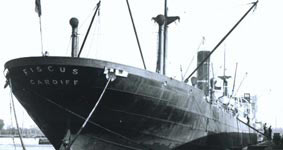SS Fiscus

| |
| Career | |
|---|---|
| Name: | SS Fiscus |
| Operator: | W.H. Seager & Co Ltd, Cardiff |
| Builder: | Northumberland Shipbuilding Co (1927) Ltd, Howden on Tyne |
| Completed: | 1928 |
| Fate: | sunk on 18 October 1940 |
| General characteristics | |
| Class and type: | Steam merchant ship |
| Tonnage: | 4,815 tons |
| Crew: | 39 |
The SS Fiscus was a steam merchant ship that sailed under the British flag, and saw service in the Second World War, when she was sunk.
Career and sinking
The Fiscus was built in 1928 by the Northumberland Shipbuilding Co (1927) Ltd, Howden on Tyne and entered service with W.H. Seager & Co Ltd, Cardiff. She was homeported in that city. During the Second World War she was used to bring supplies to Britain, travelling in convoys to reduce the threat of Germany's u-boat fleet. She made a number of transatlantic crossings during 1940, before joining the ill-fated convoy SC-7 in October 1940.
She sailed from Three Rivers to Sydney, Nova Scotia to join the convoy assembling there. She sailed in company with the other ships of the convoy on 5 October under the command of her master, Ebenezer Williams, and carrying a cargo of steel, lumber and a deck cargo of crated aircraft. On arrival on British waters she was to proceed to the Clyde. The convoy was overwhelmed by u-boats utilising wolf pack tactics during the crossing, and many of the merchants were torpedoed and sunk. The Fiscus was sighted by U-99 under the command of Otto Kretschmer and at 23.55 hours on 18 October he torpedoed the Fiscus east of Rockall. She sank almost immediately. Her master, 36 crew members and one gunner were lost, leaving a sole survivor. He was spotted standing on some debris by a lifeboat from the Snefjeld which had been sunk earlier by U-99. They took him aboard and were all rescued on 23 October by HMS Clematis.
